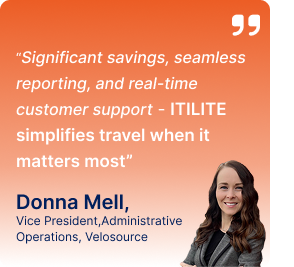
As the work landscape evolves, effectively managing travel expenses for remote employees has become increasingly important. It requires careful attention and strategic oversight for financial reasons and to ensure a productive and contented remote workforce.
Mastering the intricacies of managing remote employee expenses demands a nuanced approach that balances efficiency, transparency, and employee satisfaction. You must establish clear policies, harness advanced technology, and foster a culture of prudent spending, which are essential elements for effective expense management.
This guide aims to equip you with practical strategies and actionable tips to navigate the intricate terrain of remote employee spending while streamlining expense management practices.
Let’s look at some of the strategies you can implement to manage remote employee travel expenses:
1. Establish Clear Expense Policies
As a manager of remote employees, one of the most important things you can do when managing travel expenses is to set clear policies. The process will help set expectations upfront for both you and your employees.
To begin with, outline specific requirements for expense pre-approval. Ensure employees get approval before booking flights and hotels for non-routine travel. You’ll want to set a threshold, like requiring pre-approval for any expenses above $500. This ensures you have visibility into significant costs.
Also, be sure to communicate your requirements around receipts and documentation. For instance, you may require itemized receipts for expenses over $75. Outline what types of receipts are acceptable. Additionally, set limits on categories like hotels, meals, and airfare based on your budget. Enforcing limits helps prevent overspending.
Finally, be very clear about your reimbursement process and timeline. For example, you might set a 15-day window for employees to submit expenses for reimbursement after completing travel. The more precise your policies, the smoother your remote employee expense management process will be.
2. Use Expense Management Software
Managing remote employee travel expenses effectively requires using dedicated expense management software. The right software centralizes expense management and provides automation, reporting, and analytics.
Look for software that offers features like:
- Mobile app for employees to submit expenses on-the-go
- Integrations with accounting, payroll, and travel booking systems
- Smart workflows for streamlined approvals
- Automated flagging of duplicate, unusual, or policy-breaking expenses
- Digital receipt capture using a phone camera or email
- Mileage and per diem calculation
- Reporting and analytics for spend visibility
The software’s automation, visibility, and control are invaluable for managing remote employee travel expenses effectively. Employees can easily submit costs, no matter where they are. Managers gain transparency into spending with reporting and analytics.
Choosing the best expense management software solution will significantly improve your team’s travel and expense process. Expenses will be accurately captured upfront and routed for seamless approval. It saves time for employees and managers while reducing errors and spending leakage.
3. Automate What You Can
Automation is vital for efficient remote employee expense management. Set up rules to automatically integrate corporate card expenses, capture receipts, match expenses to approvals, and more. It eliminates manual data entry and reduces the chance of errors.
Specifically, look for software that offers:
- Corporate card integration to automatically import charges
- Receipt capture via mobile app for easy submissions
- Matching receipts to expenses for seamless tracking
- Auto-coding expenses based on the merchant, amount, etc.
- Approval workflows to route expenses for review
- Reporting that highlights spending patterns
The less your team has to do manually, the better. Automation saves significant time while also boosting accuracy. Employees can focus on more strategic work rather than administrative tasks.
Set your software to require receipts, match them to card charges, and auto-approve amounts under a set limit. Review one-off larger purchases but automate the routine daily expenses. Customizable rules adapt as your business evolves.
Automation also aids compliance. The software can flag suspicious charges or duplicate expenses for review. You get alerts for policy violations, too. This protects the company from fraud and abuse.
4. Prioritize Visibility
Granting managers visibility into remote employee spending is paramount for effective expense management. Hence, you must implement spending limits and mandate pre-approvals for significant expenses. Utilize reporting functionalities within your expense software to track budgets against actual spending. Define guidelines for pre-approvals based on expense amount and type.
5. Enable Mobile Access
When managing remote employee expenses, enabling easy mobile access to your expense management system is crucial. Offering a dedicated mobile app allows remote staff to track costs easily on the go via their smartphone.
Rather than having to keep paper receipts or manually enter expenses, employees can quickly photograph and upload receipts directly into the app. The app also allows easy mileage tracking if employees use their vehicles.
Providing an expense management app removes friction from the expense reporting process. Remote employees will be more likely to closely track expenses if they can do it from their phone right away versus saving up receipts and entering them later. Real-time mobile access leads to more accurate and timely expense data.
With extensive business travel, mobile entry of expenses can save remote staff tons of time compared to manual processes. Mobile is one of the most significant advantages of automated expense management systems. Take advantage of this capability when managing your remote team’s spending.
6. Offer Payment Flexibility
Provide options like corporate cards, reimbursements, and direct payments to your remote staff to give them flexibility when paying for travel expenses.
When managing business travel expenses, corporate credit cards can provide a straightforward solution. However, if you prefer more autonomy, reimbursement might be your choice. With this method, you cover expenses upfront and then submit reports for reimbursement. Consider direct billing, where merchant payments are arranged immediately, bypassing your need for upfront payment. For instance, you can book flights and hotels directly, avoiding the reimbursement process altogether.
The key is finding the right balance and mix of payment types that allow employees to manage expenses with minimal hassle while maintaining control and oversight. Offer your remote staff options so they can choose what works best. But be sure to set clear guidelines on when each method can be used.
7. Monitor Ongoing Expenses
While setting expense policies and forgetting about them is tempting, regular monitoring and auditing are essential. You should review remote employee spending patterns quarterly. Look for any inappropriate purchases, double expenses, or other red flags. Analyze if certain employees have much higher costs than their peers and why. Track expenses over time to identify any problematic trends or fluctuations.
Your remote team is dynamic, so you must be ready to adjust policies accordingly. If many employees submit expenses you initially ruled out, reconsider your criteria. As new tools emerge, reevaluate processes to streamline approvals. When business or market conditions shift, reassess the appropriateness of per diems, mileage rates, and limits. Stay on top of regulatory and tax law changes as well.
Keep an open dialogue with your accounting department and remote employees. Ask for feedback on where policies can be clarified or improved. By regularly monitoring and fine-tuning your approach, you can better control costs and prevent fraud. Audits and adjustments ensure your remote employee travel expenses stay reasonable and compliant over time.
8. Consider Tax Implications
When managing remote employee travel expenses, it’s essential to consider the tax implications. The tax rules can vary greatly depending on the locations your remote employees are traveling to.
For instance, some countries may have particular regulations regarding business meal deductions, mileage rates, reimbursements, etc. Make sure you understand how taxes apply for each location. Connect with a knowledgeable accountant to ensure you remain compliant across multiple geographies.
Some of the best practices include:
- Reviewing local tax laws for all locations remote employees travel to.
- Refrain from assuming the rules will be the same.
- Keeping detailed records of the business purpose and final cost for every expense.
- Paying attention to receipts and changing exchange rates
- Keep track of tipping differences, and reimbursable rates.
- Consider corporate taxes may apply if your company has an official presence in a country.
- Withholding taxes if you reimburse international employees directly.
- Track expenses correctly in your accounting system and keep an audit trail.
- Having employees submit expenses as soon as possible after a trip to avoid confusion.
Proper remote employee expense management starts long before tax time. Staying on top of expectations, documentation, and jurisdictional differences will make tax compliance much smoother for your remote and traveling employees. You must track to avoid overly high tax bills.
Manage Remote Employee Travel Expenses Seamlessly
With suitable systems and policies in place, business travel management and expenses for remote staff can become much more efficient. Focus on streamlining the process as much as possible using technology. But also build in oversight to ensure compliance. Keep policies clear and up-to-date. With a balanced approach, your remote team can travel, and you can effectively manage expenses.
One of the best ways to manage travel expenses for remote employees is by leveraging expense management software such as itilite. Itilite expense management software automates your expense processes by integrating expense filing, approvals, and reimbursements in one platform. Features such as digital receipt management, real-time fraud detection, automatic expense report generation, and much more help you optimize travel expenses for remote employees.
To know more about itilite advanced features, contact our experts now!













